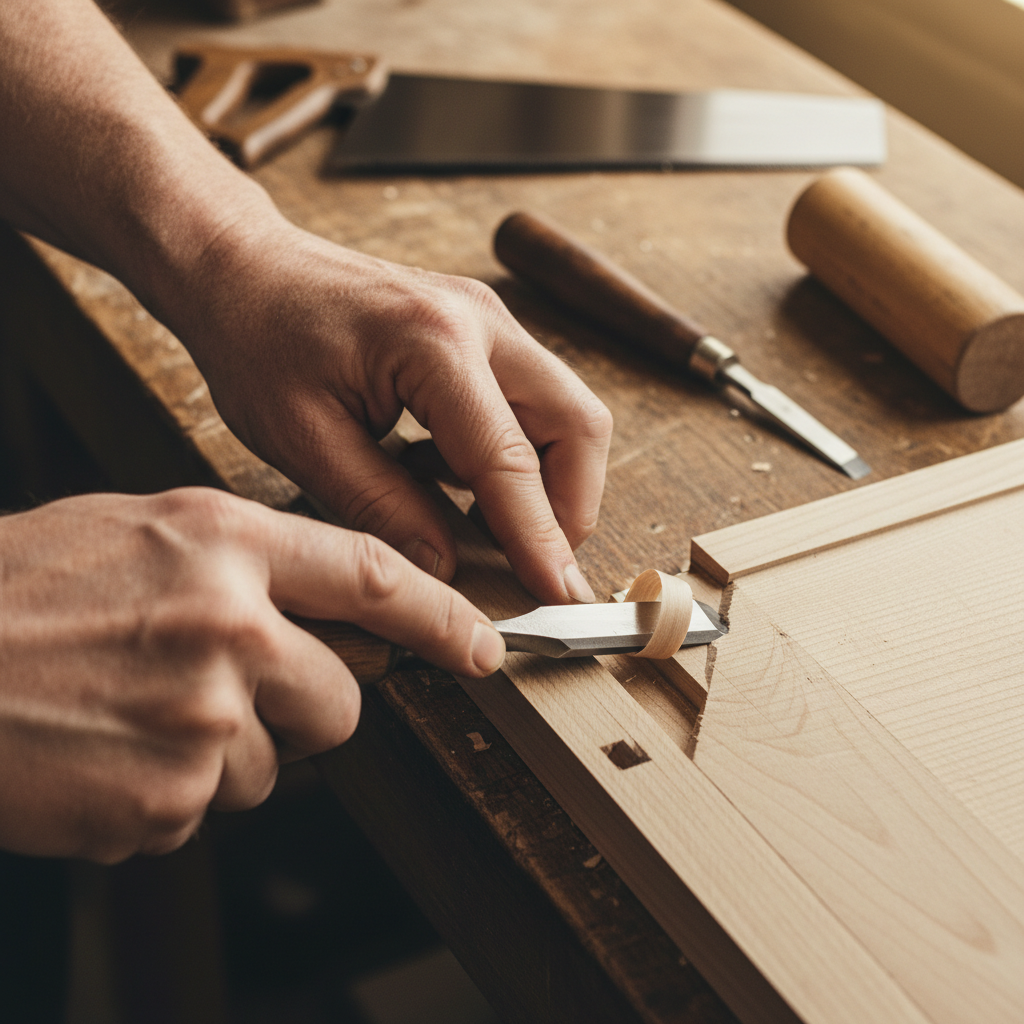Hey there, fellow woodworking enthusiast! Have you ever found yourself scrolling through Instagram, admiring those stuing, intricate hand-cut dovetail joints, and thought, “Wow, that looks amazing, but I bet I need a workshop full of expensive tools and years of experience to do that”? Well, let me tell you, you’re not alone. I’ve been there, staring at those perfect joints, convinced it was a skill reserved for master craftsmen with hefty bank accounts.
But here’s a little secret I discovered on my own woodworking journey: hand-cut dovetails are absolutely within your reach, even if your tool budget is tighter than a drum and your experience level is, well, zero. Trust me, I started with a handful of basic tools, many of them second-hand or entry-level, and a whole lot of scrap wood. The truth is, the magic of dovetails lies more in patience, precision, and understanding the technique than in the price tag of your tools.
In this guide, I want to walk you through how you can achieve beautiful, strong hand-cut dovetail joints without breaking the bank. We’ll talk about the essential tools you *actually* need (and how to acquire them affordably), the steps involved, and most importantly, the mindset that will turn frustration into fascination. So, grab a cup of coffee, and let’s demystify this woodworking rite of passage together!
Why Hand-Cut Dovetails Anyway? The Allure of Tradition
Before we dive into the nitty-gritty, you might be wondering, “Why bother with hand-cut dovetails when machines can do it faster and maybe even ‘perfectly’?” It’s a valid question. For me, and for many woodworkers, the appeal goes far beyond mere function. Yes, dovetail joints are incredibly strong and durable, thanks to their interlocking design. They’re a hallmark of quality craftsmanship, a testament to a piece of furniture built to last generations.
But there’s also an immense satisfaction that comes from creating something beautiful and functional with your own hands. It’s a coection to centuries of woodworking tradition. Each joint you cut, each shaving you remove, is a deliberate act of creation. And let’s be honest, there’s a certain swagger in being able to say, “Yeah, I cut those by hand.” It’s a skill that elevates your woodworking, instills confidence, and opens up a world of project possibilities.
The Essential Tool Kit (And How to Keep it Budget-Friendly)
Alright, let’s talk tools. The good news is, you don’t need a fortune. Here’s my personal list of must-haves for begiers, with tips on how to get them without overspending:
-
A Good Marking Knife:
This is non-negotiable for precision. Forget pencils for critical lines. A sharp marking knife creates a fine, crisp line that your saw can register against. You can find decent ones for under $20, or even repurpose a sharp utility knife blade in a pinch.
-
Dovetail Saw:
You need a fine-toothed saw. My absolute recommendation for begiers (and even experienced pros) on a budget is a Japanese pull saw. They’re incredibly sharp, easy to control, and surprisingly affordable (often $20-$40 for a good entry-level one). They cut on the pull stroke, which gives you excellent control and less effort. Forget expensive Western-style saws for now.
-
Chisels:
Ah, the heart of hand-cut joinery. You don’t need a full set of 12. Start with three to four chisels: perhaps a 1/4 inch (6mm), a 1/2 inch (12mm), and a 3/4 inch (19mm). Maybe add a 1/8 inch (3mm) if you’re feeling adventurous. Look for affordable brands like Narex or Stanley Sweetheart (the newer ones are decent). Or, hit up flea markets and antique shops for old chisels – they can often be restored to excellent working condition for a fraction of the cost.
-
Sharpening Stones/System:
This is where many begiers fall short, and it’s perhaps the most important “tool” of all. Dull chisels and saws are more frustrating than a tangled ball of yarn. You need something to sharpen your chisels and plane blades (if you’re using a hand plane). A couple of water stones (coarse and fine) or sandpaper on a flat surface (the “Scary Sharp” method) can get you started for under $50. Trust me, learning to sharpen well will change your woodworking life.
-
Mallet:
You’ll need something to tap those chisels. A basic wooden mallet is perfect and can be bought cheaply or even made from scrap wood.
-
Marking Gauge:
Essential for consistently marking the shoulder lines on your wood. A simple mortise and marking gauge with a single pin is usually sufficient. Again, affordable options are plentiful.
-
Straightedge/Try Square:
For ensuring square cuts and accurate marking. A small engineer’s square or a good quality try square is a must-have.
-
Coping Saw:
This little gem is great for quickly removing the bulk of the waste wood between your dovetails, saving your chisels for the fine paring work. You can get a decent one for around $15-$20.
-
Clamps & Workbench:
You need a stable surface to work on and a way to hold your wood securely. A basic workbench or even a sturdy table with a couple of F-clamps or C-clamps will suffice.
Setting Up for Success: Your Workspace Matters
You don’t need a huge, dedicated workshop. My first dovetails were cut on a folding workbench in a spare corner of my garage. What you DO need is a stable surface that won’t wobble when you’re sawing or chiseling. Good lighting is also crucial – you need to see those lines clearly! Position a task light directly over your work if natural light isn’t enough. Finally, ensure you have a comfortable working height. Bending over for long periods is a recipe for fatigue and mistakes.
Understanding the Dovetail Joint: Pins vs. Tails
Let’s talk about the anatomy of a dovetail. It’s essentially two interlocking parts: the “tails” and the “pins.” The tails resemble a dove’s tail (hence the name!) and are wider at the outside edge, tapering inwards. The pins are the narrow parts that fit between the tails. For begiers, I strongly recommend cutting the “tails first” method. It tends to be more forgiving and easier to transfer accurately.
Step-by-Step: Cutting Your First Dovetail (The “Tails First” Method)
This is where the rubber meets the road! Remember, take your time, breathe, and enjoy the process.
Preparation is Key
Start with two perfectly square pieces of wood. This is crucial! Any out-of-squareness will compound into a messy joint. Using your marking gauge, scribe your baseline (the shoulder line) on both pieces of wood. This line marks the depth of your joint. Next, mark out your tail layout on the end grain of one piece. There are various ways to lay out tails – a simple layout for begiers might be two tails with one pin in the middle. Use a dovetail marker or a sliding bevel set to a common angle like 1:6 (for hardwoods) or 1:8 (for softwoods) to mark your tail angles onto the face of the wood, extending down to your baseline.
Cutting the Tails
Now, grab your dovetail saw. Position your wood securely in a vise, end grain up. Start sawing just *outside* your marked lines (the waste side), letting the saw do the work. Don’t force it. Focus on keeping your saw plumb (straight up and down) and following your lines. Saw down to your baseline. Once you’ve cut all your tail angles, you’ll have the outline of your tails.
Removing Waste (Between Tails)
Next, use your coping saw to remove the bulk of the waste wood between your tails. Cut close to your baseline, but leave a tiny bit of material for your chisels. Then, with your sharp chisels and mallet, pare precisely down to your baseline. Hold the chisel bevel-down for the initial paring, then bevel-up for final, delicate cleanup. Take shallow cuts. You want a clean, flat surface.
Transferring to Pins: The Moment of Truth
This step requires utmost precision. Place the tail board firmly onto the end grain of your pin board, making sure the shoulder lines are perfectly aligned. Clamp them together securely. Now, using your sharp marking knife, carefully trace the outline of the tails onto the end grain of the pin board. Press firmly to get a crisp, deep line. This is the blueprint for your pins!
Cutting the Pins
Unclamp and secure your pin board in the vise. Using your dovetail saw, carefully saw down to your baseline, again staying *just outside* your knife lines (on the waste side). It’s incredibly tempting to saw right on the line, but that will result in a loose joint. Err on the side of leaving a hair’s breadth of material. Take your time, focus, and let the saw guide you.
Removing Waste (Between Pins)
Similar to the tails, use your coping saw to remove the bulk of the waste between the pins. Then, with your sharp chisels, pare down to your baseline and carefully clean up the inside of the pin recesses. Focus on creating flat, smooth surfaces that will mate perfectly with the tails.
The Fit
Now for the exciting part! Gently try to fit the two pieces together. If they don’t slide in easily, resist the urge to force them. Instead, identify the high spots (the areas preventing the fit) – often, you’ll see shiny spots where the wood is rubbing. Use your marking knife and chisels to very, very carefully remove tiny slivers from those high spots. Go slow, test often. A perfectly fitting dovetail should go together with light pressure, perhaps needing a gentle tap with a mallet.
Common Pitfalls & How to Avoid Them
-
Dull Tools:
I can’t stress this enough. Dull tools make accurate work impossible and are actually more dangerous. Invest in sharpening and learn to do it well.
-
Rushing:
Dovetails demand patience. Speed will come with practice, but precision comes first.
-
Inaccurate Marking:
Take your time with the marking knife and gauge. A sloppy start leads to a sloppy finish.
-
Sawing on the Wrong Side of the Line:
This is a classic! Always double-check which side is waste and which is keeper before you saw.
-
Forcing the Joint:
If it doesn’t fit, don’t force it! You’ll just bruise the wood and potentially damage the joint. Stop, assess, and pare down the high spots.
Practice, Practice, Practice!
Your first dovetail might not be perfect. Mine certainly wasn’t! It might have gaps, the angles might be off, or you might struggle with the paring. And that’s absolutely okay. Every single joint is a learning experience. Start with cheap scrap wood. Cut a dozen, twenty, fifty joints if you have to. Each one will teach you something new about your tools, your technique, and your own hand-eye coordination. Focus on consistency over speed. Soon, you’ll find that rhythm, and those beautiful, tight dovetails will start appearing as if by magic.
Conclusion
So, there you have it. The secret to hand-cut dovetail joints isn’t a secret at all – it’s a combination of a few affordable, essential tools, a methodical approach, and a whole lot of patience and practice. You don’t need to mortgage your house for fancy equipment. What you need is the willingness to learn, the dedication to hone your skills, and the joy of creating something truly handmade.
Go ahead, get those basic tools, grab some scrap wood, and give it a try. Your first dovetail might not be perfect, but it will be yours, and it will be the begiing of a incredibly rewarding journey in woodworking. Happy chiseling, my friend!



